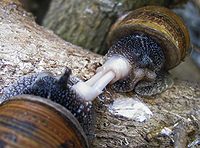
Photo from wikipedia
Abstract The genetic diversity and population structure of oriental thin-skinned melons, Cucumis melo subsp. agrestis, remain incompletely clear to date. In the present study, 163 melon accessions (153 subsp. agrestis… Click to show full abstract
Abstract The genetic diversity and population structure of oriental thin-skinned melons, Cucumis melo subsp. agrestis, remain incompletely clear to date. In the present study, 163 melon accessions (153 subsp. agrestis and 10 subsp. melo accessions) mainly from India and China were examined for genetic diversity and population structure using a core set of 37 simple sequence repeat (SSR) markers evenly distributed across the 12 melon chromosomes. A total of 274 alleles were detected with the allelic number per marker ranging from 3 to 16 (mean = 7.40) and polymorphism information content (PIC) from 0.342 to 0.770 (mean = 0.524). With the SSR genotype data, two main groups (I and II), mainly represented by Indian and Chinese subsp. agrestis accessions, respectively, were obtained by the unweighted pair group method with arithmetic mean (UPGMA) and the principal component analysis (PCA). Group I contained 24 Indian subsp. agrestis landraces and four accessions from America and Maldives while group II was consisted of 122 Chinese accessions and 13 accessions from other seven countries. There existed a clear divergence between Indian and Chinese subsp. agrestis melons, resulting in two independent germplasm pools. Group II mainly represented by East Asian accessions could be further divided into three subgroups (II-1, II-2, and II-3). The analysis of molecular variance (AMOVA) and pairwise F statistics (FST) were performed to quantify the genetic differentiation among the whole panel, displaying a strong differentiation between Indian and Chinese subsp. agrestis accessions but a comparatively weak differentiation within East Asian pool. From these findings, Indian and Chinese subsp. agrestis accessions have a distant relationship with each other and probably undergo different domestication pathways in their domestication history. Our results provide useful information for pursuing the genetic diversity and structure of oriental thin-skinned melon resources, which will favour efficient utilization of these valuable germplasms in modern agriculture and breeding.
Journal Title: Scientia Horticulturae
Year Published: 2018
Link to full text (if available)
Share on Social Media: Sign Up to like & get
recommendations!